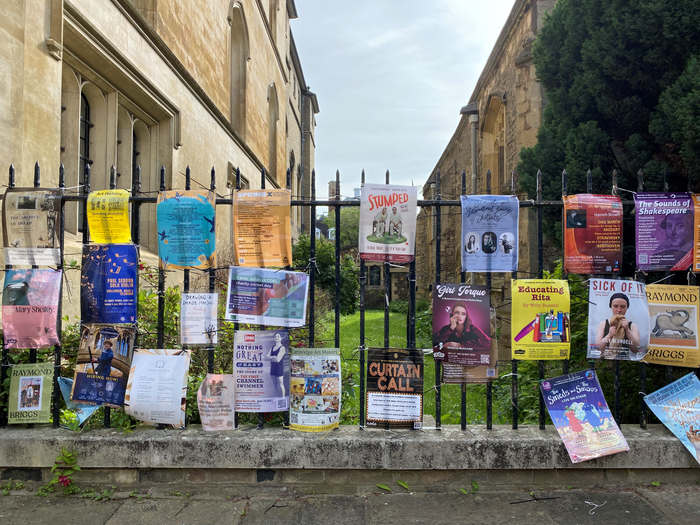Love letters to Cambridge theatre
Letters to our favourite aspects of the theatre scene, from underrated open-mics to enrapturing choreography

Michael Elizabeth, Wolfson Howler
My dearest Wolfson Howler! Who could have guessed you would become a fixture of my life in Cambridge? In a city so full of comedy, I found the best option at my doorstep. Cheap drinks, an enthusiastic audience, professional acts from London: a comedy-lover’s dream. And only £5 – or free for Wolfson members? The ADC could never.
The range of emotions I have felt at the Howler can only be compared to the feelings elicited by an Oscar-worthy film. Howlers have brought me from the highest heights of joy while watching Ted Hill joke about American presidents to the deepest pits of fear while witnessing Elf Lyons mime a spider eating a trapped fly.
Performing at the Howler is a unique pleasure for comedians passing through the Cambridge scene. I felt so nervous to perform because I knew this was the big leagues compared to other opportunities in Cambridge (sorry, Footlights). Getting paid at the end of the night was icing on cake.
So, my darling Wolfson Howler, while we've already said our farewells, I’m looking forward to all the Howlers that next academic year will bring.
Supriya Finch, Sunday in the Park with George
I try not to discuss professionalism in my reviews. After all, the A in ADC stands for amateur. It’s a totally unrealistic standard for student-produced, student-directed and student-acted theatre. Or at least, it nearly always is.
“There wasn’t a single stumble, missed note or technical hitch”
Sunday in the Park with George was mind blowing. Having paid less than £10, I was treated to a West End level production. There wasn’t a single stumble, missed note or technical hitch. Patchy costume and set proved that the production was operating on a student budget, but showed that it was operating well on a student budget. Set design was creative, with a strikingly abstract approach, and the costume certainly didn’t impede the magical tableau of A Sunday Afternoon on the Island of La Grande Jatte, at which I couldn’t help but gasp aloud.
I’ll always see George as Eoin McCaul (who I often see out rowing – is there anything this man can’t do?), whose performance glowed with grace and energy, as did Annie Stedman’s Dot, with both of their incredibly powerful voices filling the ADC with ease. Sunday remains a gold standard for student theatre: something so good that it almost seems unrepeatable.
Imogen Garfinkel, Electra: Haimara
Irisa Kwok’s balletic gliding across the stage at the climax of Electra: Haimara was devastating and dazzling. The incorporation of dance into theatre, when pulled off, creates a sensory feast for an audience. The combination of dusky, warm lights and rhythmic, pulsing music encased Kwok’s spectral silhouette, rendering them an ambivalent, liquidy shadow. I will not forget the meta-theatrical innovation and audacity of Kwok, who doubled as not merely the writer, but also the solitary dancer of Electra: Haimara.
“Dance signals this fading away and fracturing of discourse”
The play of endless mourning and elusive revenge explores the tragic inability of language to ever console, its ultimate failure to connect us to each other and ourselves. Dance signals this fading away and fracturing of discourse, as painful, verbal stuttering transforms into the body’s mysterious choreography. The presence of dance in theatre ensures that every performance differs. Each production of Electra: Haimara will have been uniquely stamped by the wayward corporeality of the dancer, whose protean movements left an ephemeral trace on stage each night. My memory of Electra: Haimara thus exceeds its written archive, for words can only gesture towards the embodied lyricism of Kwok, whose movements still dance in my mind.
Lottie Wood, Under Milk Wood
Although I wouldn’t yet call myself a techie, my forays into operating lighting have left me with a newfound appreciation for seeing a play night in, night out; from sometimes unconventional views of the stage, seeing different audience responses and gaining a newfound appreciation for the script. During Under Milk Wood I found myself willingly volunteering to sit behind the white curtain drape and manually plug and unplug the difficult backlight at certain points in the play. Cross-legged in the dark, I couldn’t see the stage, but this was fitting for Dylan Thomas’s “play for voices”, originally broadcast on radio. There was an illusive, magical quality to having the physicality of the play hidden, focusing solely on Thomas’s dreamlike lyricism narrated by a wonderful cast. You don’t quite grasp some plays on the first listen, but the characters’ stories resonated with me more each night, weaving together to create the small Welsh village. I was lulled into the poetic narration, occasionally pulling myself back to deliver my cues. The reverend’s “dear Gwalia!” sermons and Mog and Myfanwy’s declarations of love were rolling around my head and on the tip of my tongue each day.
 News / Cambridge academics stand out in King’s 2026 Honours List2 January 2026
News / Cambridge academics stand out in King’s 2026 Honours List2 January 2026 Interviews / You don’t need to peak at Cambridge, says Robin Harding31 December 2025
Interviews / You don’t need to peak at Cambridge, says Robin Harding31 December 2025 Comment / What happened to men at Cambridge?31 December 2025
Comment / What happened to men at Cambridge?31 December 2025 News / Varsity’s biggest stories of 202531 December 2025
News / Varsity’s biggest stories of 202531 December 2025 Features / “It’s a momentary expression of rage”: reforming democracy from Cambridge4 January 2026
Features / “It’s a momentary expression of rage”: reforming democracy from Cambridge4 January 2026










